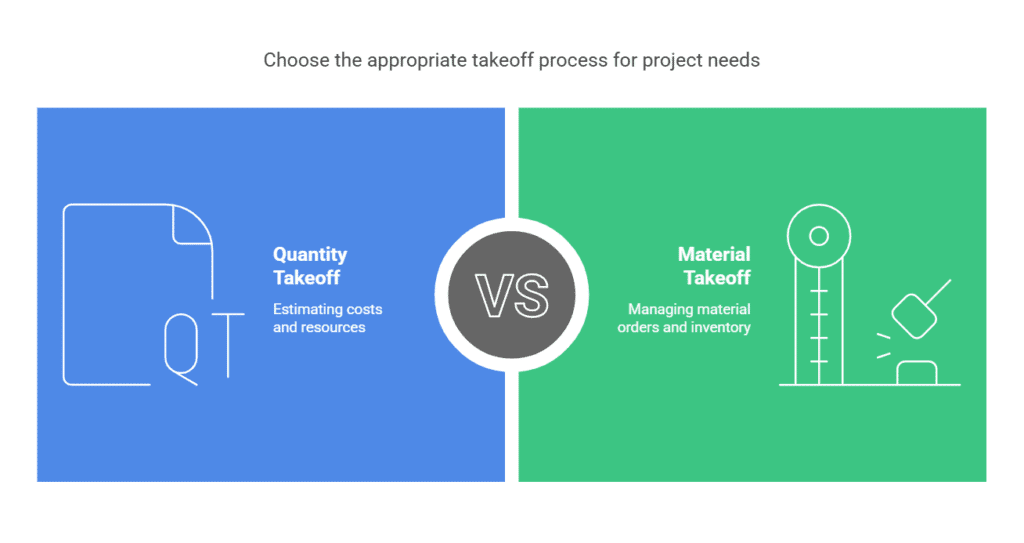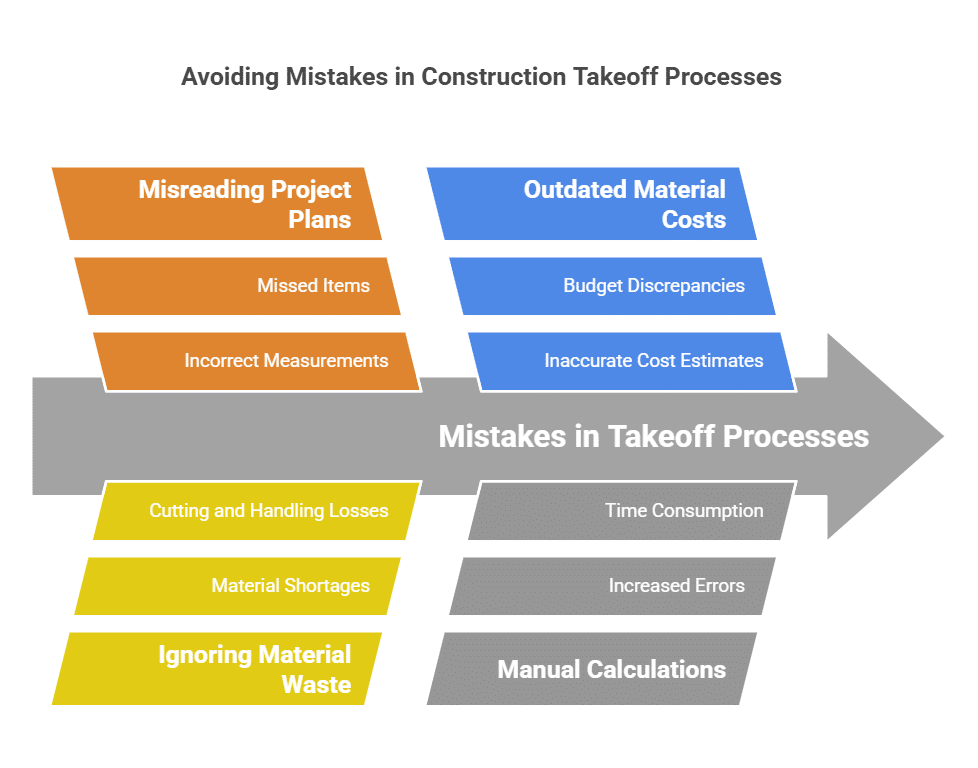Ranked #1 in Accurate and Reliable Estimation Services
A Fastest Turnaround 24 Hours!
Ranked #1 in Accurate and Reliable Estimation Services
A Fastest Turnaround 24 Hours!
Ranked #1 in Accurate and Reliable Estimation Services
A Fastest Turnaround 24 Hours!
Ranked #1 in Accurate and Reliable Estimation Services
A Fastest Turnaround 24 Hours!

In construction, proper planning is key to completing projects on time and within budget. Two important steps in this process are Quantity Takeoff (QTO) and Material Takeoff (MTO). Although these terms sound similar, they serve different purposes. Knowing the difference helps improve accuracy, reduce waste, and save money. In this article, we will explain quantity takeoff and material takeoff in simple terms. We will also cover why they are important, how they work, and how technology makes them easier.
Quantity Takeoff is the process of measuring everything needed to complete a construction project. It includes materials, labor, and equipment. This process is essential because it helps estimate the total project cost, supports accurate budgeting and scheduling, and provides detailed information for contractors and project managers.
When performing a quantity takeoff, it involves measuring various elements. These include materials like concrete, steel, and wood. It also considers the labor required, such as the number of work hours needed to complete specific tasks. Additionally, it accounts for equipment like tools and machines essential for the project.
The quantity takeoff process typically starts by studying the project plans, including blueprints and technical drawings. After understanding the scope, the next step is to measure and calculate the quantities of all required components. Many professionals use digital tools like Bluebeam or PlanSwift to speed up this process and improve accuracy. Once the data is gathered, it is compiled into a detailed report for cost estimation and project planning.
Quantity takeoff is primarily used by estimators, contractors, and project managers. These professionals rely on accurate measurements to plan resources, avoid costly mistakes, and ensure the smooth execution of construction projects.If you want to learn more, check out our detailed guide on what is quantity off for a comprehensive understanding of how quantity takeoff works and its importance in construction projects.
Material Takeoff focuses only on listing and measuring the physical materials needed for a project. This process is vital because it ensures the correct materials are ordered, helps with planning delivery and storage, and reduces waste while preventing shortages.
Material takeoff involves identifying and recording every physical item required for the project. This includes materials like bricks, pipes, and tiles. Each material is listed with specific details such as size, type, and quantity. Accuracy is crucial because mistakes in this stage can lead to delays or increased costs.
The material takeoff process begins by carefully reviewing the project drawings to determine the materials needed. After identifying the materials, a comprehensive list is created. It is also important to allow for extra material to cover potential waste caused by cutting or errors. The final output is a clear and organized material list that can be used for purchasing and delivery scheduling.
Material takeoff is commonly used by procurement teams, project managers, and suppliers. These groups depend on accurate material lists to ensure the right items are available when needed and to avoid project delays.
While quantity takeoff and material takeoff share some similarities, they have clear differences in focus, purpose, and process. Quantity takeoff covers all project components, including materials, labor, and equipment, while material takeoff only deals with physical materials. The primary purpose of quantity takeoff is to estimate project costs and resources. In contrast, material takeoff ensures accurate material orders and helps manage inventory.
Different professionals use these processes. Estimators, contractors, and surveyors typically use quantity takeoff to understand project costs and timelines. On the other hand, procurement teams and suppliers use material takeoff to manage material purchasing and deliveries. The outputs also vary; quantity takeoff produces detailed cost reports, while material takeoff generates specific material lists.

Both quantity takeoff and material takeoff play crucial roles in successful construction projects. Accurate takeoffs ensure better budgeting, efficient use of resources, and improved project planning. Without these processes, projects are more likely to face cost overruns, delays, and material shortages.
Quantity takeoff provides a comprehensive overview of everything required, making it easier to estimate the total project cost accurately. This detailed breakdown is essential for creating realistic budgets and schedules. Material takeoff, by focusing on physical materials, helps prevent ordering errors, ensures timely deliveries, and reduces material waste. Together, these processes contribute to smooth project execution and better resource management.

Mistakes in takeoff processes can lead to significant problems, including increased costs and project delays. One common mistake is misreading project plans, which can result in incorrect measurements or missed items. To avoid this, always use the most up-to-date and accurate blueprints.
Another frequent error is ignoring material waste. Construction projects often require extra materials to account for cutting and handling losses. Failing to include this buffer can lead to material shortages. It is also important to update material costs regularly, as outdated information can cause budget discrepancies. Manual calculations are another source of errors. Using digital tools can reduce mistakes and speed up the process.
Advancements in technology have made takeoff processes more efficient and accurate. Digital tools help streamline measurements, reduce human error, and improve collaboration across project teams. Several popular takeoff software solutions are widely used in the construction industry.
Bluebeam is a common choice for digital measurement and documentation. PlanSwift allows for fast and accurate takeoff directly from blueprints. Autodesk Takeoff integrates with 3D modeling software, providing advanced planning capabilities. These tools offer significant benefits, including faster calculations, easier collaboration, real-time updates, and better reporting.
The future of quantity and material takeoff is evolving with new technology. One significant trend is the use of artificial intelligence and automation, which speeds up calculations and improves accuracy. Cloud-based systems are also becoming more common, allowing teams to access and update data from any location.
Building Information Modeling (BIM) is another emerging trend. It integrates 3D models with takeoff processes, offering more precise measurements and improved project visualization. There is an increasing emphasis on sustainability. Modern takeoff processes now include tracking and reducing material waste, helping construction companies meet environmental goals.
Understanding the difference between quantity takeoff and material takeoff is essential for successful construction planning. Quantity takeoff involves measuring all project components, including materials, labor, and equipment, to provide a comprehensive cost estimate. Material takeoff focuses only on the physical materials required, ensuring accurate orders and efficient resource management.
Both processes are crucial for accurate budgeting, efficient project execution, and error prevention. Modern digital tools have made these tasks faster and more precise, and emerging technologies like AI and BIM continue to improve efficiency. By mastering both quantity and material takeoff, construction professionals can save time, reduce waste, and deliver successful projects with greater confidence.
0 Comments